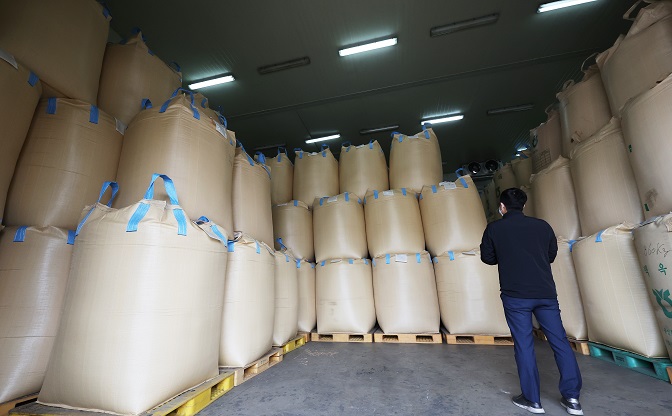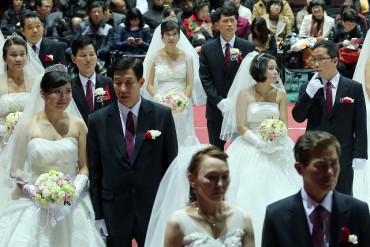
An official checks the quality of preserved rice at a rice processing cooperative in Yongin, 40 kilometers south of Seoul, on April 4, 2023. President Yoon Suk Yeol vetoed a contentious bill the same day that requires the government purchase of surplus rice. (Yonhap)
SEOUL, April 6 (Korea Bizwire) — South Korea will reduce rice paddy areas and implement various measures to promote the consumption of the staple grain in a move to prevent rice prices from falling and stabilize the market, the agriculture ministry said Thursday.
The government set the target price for harvested rice at 200,000 won (US$151.61) per 80 kilograms this year, up from 187,268 won last year.
For the goal, the country seeks to reduce the rice paddy areas by around 5 percent this year to adjust output by offering subsidies to farmers when they cultivate other kinds of crops, such as rice flour and beans, and when they agree to cut rice output, according to the ministry.
The combined size of rice paddy areas came to around 727,000 hectares last year, and the government is pushing to reduce it to 661,000 hectares by 2025.
The ministry also vowed to support the development of quality varieties of rice and the release of rice-based products to promote rice consumption.
It set the goal of boosting exports of rice-related products to US$300 million by 2027 from last year’s $182 million.
“We will take financial and policy supports preemptively and more actively to encourage farmers to cultivate various crops to strike a balance between supply and demand, and to ensure food sufficiency,” the ministry said.
The government annually purchases a certain amount of homegrown rice to help stabilize the domestic rice market amid a chronic supply glut and to provide subsidies to rice farmers.
The oversupply comes in line with falling demand in recent decades due mainly to changes in diet and eating habits.
Last year, the country’s rice output came to 3.76 million tons, and the government spent around 1 trillion won on purchasing around 450,000 tons of rice.
In March, the National Assembly passed the revision to the Grain Management Act that requires the government to buy excess rice if production exceeds estimated demand by 3 to 5 percent or if prices fall by 5-8 percent or more on-year.
But President Yoon Suk Yeol earlier this week vetoed it amid criticism it would lead to a waste of government resources.
(Yonhap)






